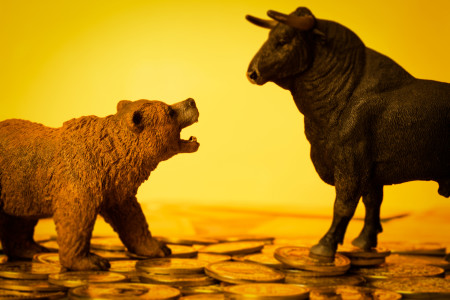
Stock markets work in the same way as farmers’ markets; but instead of buying and selling fruits and vegetables, people buy and sell stocks (portions of companies). Like many goods, the value of company shares are determined by supply and demand. When an item’s in high demand, the price goes up. Conversely, less interest can result in falling prices.
When the value of company shares moves rapidly up or down, it’s a type of market volatility. This can be unsettling for young investors, who are just starting out and may not be used to seeing the value of their savings fluctuate. However, this can also be viewed as an opportunity. Young savers have the luxury of time to ride out multiple cycles of market volatility, and by staying invested for the long-term, can grow their pension savings confidently. Here’s what you need to know:
What are bull and bear markets?
These investment terms come from the way these animals strike their opponents - a bull uses its horns to thrust upward, while a bear uses its claws to swipe downward. So, a bull market’s when stock prices are going up and a bear market’s when stock prices are going down. Bull markets are typically characterised by optimism and economic growth, while bear markets are associated with pessimism and economic recession.
The market’s status as a bull or bear can only be determined with the passage of time as stock prices can fluctuate in the short-term. For example, stock prices may go up one day and down the next. However, a bull or bear market’s identified by a sustained upward or downward trend, such as a rise or fall of more than 20% in stock market prices.
A brief history of bear markets
Bear markets can vary in length and seriousness, but they usually offer opportunities for investors to buy company shares at lower prices and benefit from the eventual recovery. Stock markets have historically trended upwards; even if there are short-term declines, the market has always recovered and gone on to reach new highs.
Older generations have lived through many cycles of market volatility, and they’ve come out ahead in the long-run. Take the Dow Jones Industrial Average in the US for example. As one of the oldest and most widely-followed stock market indices in the world, it’s weathered many bear markets in its history. Here’s a brief overview of how different generations have lived alongside market volatility, and the impact this has had on their savings.
‘The Silent Generation’ (1928-1945) and ‘Baby Boomers’ (1946-1964)
The Wall Street Crash of 1929 was one of the most famous bear markets in the past century. Triggered by bank failures and overproduction of goods, it began a four-year decline that erased nearly 90% of the Dow Jones Industrial Average’s value. The following recession, the Great Depression, lasted for over a decade and contributed to widespread poverty.
After World War II, the US economy shrank again. The combination of high inflation, reduced government spending, and returning veterans to the workforce, resulted in the Post-War Recession. Despite these bear markets, the Dow Jones Industrial Average’s value increased by 269% between 1928 and 1964.
‘Generation X’ (1965-1980) and ‘Millennials’ (1981-1996)
The Oil Crisis of 1973 was the result of political friction between the US and Middle East. The Organization of Petroleum Exporting Countries (OPEC) refused to sell oil to the US and its allies for supporting their opponent, Israel, during the Yom Kippur War. This caused oil prices to quadruple and led to a global recession.
Black Monday in 1987 was known as the most dramatic plunge in the Dow Jones Industrial Average’s history, with a record 22% fall in a single day. Overvaluation of company shares and mass panic selling were contributing factors that led to the crash. Undeterred by this, the Dow Jones Industrial Average’s value increased by 530% between 1965 and 1996.
‘Generation Z’ (1997-2012) and ‘Generation Alpha’ (2013-Present)
The Global Financial Crisis in 2008 was the worst economic downturn since the Great Depression and the most severe bear market since the Oil Crisis. A domino effect of a housing market collapse and mortgage crisis, which spilled over into the credit markets and global banking systems, led to a very painful global recession.
The COVID-19 Pandemic in 2020 caused widespread disruptions to the economy and society. The pandemic forced many countries to impose lockdowns and social distancing measures that severely affected many businesses. Even through unprecedented times, the Dow Jones Industrial Average’s value increased by 357% between 1997 and 2021.
Key takeaways
- Bear markets are normal and will come to an end.
- The average duration of a bear market’s around 10 months.
- Bull markets typically last longer than bear markets, and the gains made during them are often larger than the losses in a bear market.
- Regularly investing’s a good way to benefit from market volatility, as you’ll buy company shares at their lowest and highest prices over time without needing to worry too much about timing your investments.
Power of market volatility on investments
Bear markets are unpredictable, yet inevitable, events that often have a significant impact on investors and the economy. They’re also part of the natural cycle of markets and create opportunities for long-term investors to buy company shares at lower prices. History shows that bear markets are usually followed by bull markets that more than compensate for previous losses. And for young savers in particular, these market downturns can help accelerate long-term pension savings.
Risk warning
As always with investments, your capital is at risk. The value of your investment can go down as well as up, and you may get back less than you invest. This information should not be regarded as financial advice.




